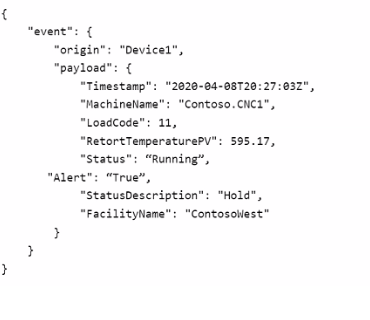
Get Microsoft AZ-220 Exam Dumps
Microsoft Azure IoT Developer Exam Dumps
This Bundle Pack includes Following 3 Formats
Test software
Practice Test
Answers (PDF)

AZ-220 Desktop Practice
Test Software
Total Questions : 204

AZ-220 Questions & Answers
(PDF)
Total Questions : 204

AZ-220 Web Based Self Assessment Practice Test
Following are some AZ-220 Exam Questions for Review
You have an Azure loT hub and an loT device that generates the following messages.

You need to route the messages to a custom Azure Event Hubs endpoint. The solution must route only messages that have the following values.

Which query should you use?

You have an Azure loT Edge device configured as a transparent gateway.
You need to define a connection string for a leaf device that uses symmetric key authentication.
Which parameters should you specify?
You have an Azure subscription named Sub1.
You need to ensure that when a new Azure loT hub is created in Sub1, a warning appears indicating that communication must be allowed only from known networks. The solution must minimize development and administrative effort.
What should you include in the solution?
You have 10 devices that connect to an Azure loT hub. Each device has a unique public IP address. The devices are not provisioned through DPS.
You discover an anomaly in messages from two devices.
You need to stop all messages from both devices without affecting the other devices.
Solution: You delete the devices from the loT hub.
Does this meet the goal?
You have an loT device that has the following configurations:
* Hardware: Raspberry Pi
* Operating system: Raspberry Pi OS
You need to deploy Azure loT Edge to the device.
Which two actions should you perform? Each correct answer presents part of the solution.
NOTE: Each correct selection is worth one point.
Unlock All Features of Microsoft AZ-220 Dumps Software
Types you want
pass percentage
(Hours: Minutes)
Practice test with
limited questions
Support